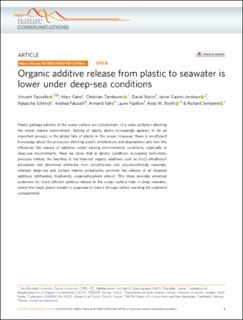| dc.contributor.author | Fauvelle, Vincent | |
| dc.contributor.author | Garel, Marc | |
| dc.contributor.author | Tamburini, Christian | |
| dc.contributor.author | Nerini, David | |
| dc.contributor.author | Castro-Jiménez, Javier | |
| dc.contributor.author | Schmidt, Natascha | |
| dc.contributor.author | Paluselli, Andrea | |
| dc.contributor.author | Fahs, Armand | |
| dc.contributor.author | Papillon, Laure | |
| dc.contributor.author | Booth, Andy | |
| dc.contributor.author | Sempéré, Richard | |
| dc.date.accessioned | 2022-10-19T07:05:11Z | |
| dc.date.available | 2022-10-19T07:05:11Z | |
| dc.date.created | 2021-07-15T11:51:09Z | |
| dc.date.issued | 2021 | |
| dc.identifier.citation | Nature Communications, 2021, 12, 4426, 1-8 | en_US |
| dc.identifier.issn | 2041-1723 | |
| dc.identifier.uri | https://hdl.handle.net/11250/3026883 | |
| dc.description.abstract | Plastic garbage patches at the ocean surface are symptomatic of a wider pollution affecting the whole marine environment. Sinking of plastic debris increasingly appears to be an important process in the global fate of plastic in the ocean. However, there is insufficient knowledge about the processes affecting plastic distributions and degradation and how this influences the release of additives under varying environmental conditions, especially in deep-sea environments. Here we show that in abiotic conditions increasing hydrostatic pressure inhibits the leaching of the heaviest organic additives such as tris(2-ethylhexyl)phosphate and diisononyl phthalate from polyethylene and polyvinylchloride materials, whereas deep-sea and surface marine prokaryotes promote the release of all targeted additives (phthalates, bisphenols, organophosphate esters). This study provides empirical evidences for more efficient additive release at the ocean surface than in deep seawater, where the major plastic burden is supposed to transit through before reaching the sediment compartment. | en_US |
| dc.language.iso | eng | en_US |
| dc.publisher | Nature Research | en_US |
| dc.rights | Navngivelse 4.0 Internasjonal | * |
| dc.rights.uri | http://creativecommons.org/licenses/by/4.0/deed.no | * |
| dc.title | Organic additive release from plastic to seawater is lower under deep-sea conditions | en_US |
| dc.type | Peer reviewed | en_US |
| dc.type | Journal article | en_US |
| dc.description.version | publishedVersion | en_US |
| dc.rights.holder | © The Author(s) 2021 | en_US |
| dc.source.pagenumber | 8 | en_US |
| dc.source.volume | 12 | en_US |
| dc.source.journal | Nature Communications | en_US |
| dc.identifier.doi | 10.1038/s41467-021-24738-w | |
| dc.identifier.cristin | 1921831 | |
| dc.relation.project | Norges forskningsråd: 257479 | en_US |
| dc.source.articlenumber | 4426 | en_US |
| cristin.ispublished | false | |
| cristin.fulltext | original | |
| cristin.qualitycode | 2 | |

